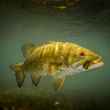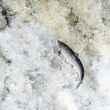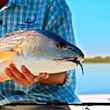Once anglers achieve success with streamers, they often focus intently on fishing big flies. The reason is simple and well known: big flies catch big fish. There's also a rush that comes with streamer fishing that doesn't come with other brands of fly fishing. Streamer fishing is distinctly different than dry fly fishing and nymphing and in most respects is more dynamic and varied terrain. Unlike these other tactics where following a few basic rules can lead to consistent success, the streamer fisherman needs to approach the water with a more predatory, evaluative eye in order to produce results.
Streamer fishing is about the world of swimming prey. Whether that prey is smaller trout, baitfish such as minnows, sculpins, leeches or something else entirely -- it swims. And imitating a swimming creature requires a different skill set and approach than imitating a drifting or floating one. Beginner streamer anglers will often try to apply the rules of the dry fly and nymphing worlds to that of the streamer fishing world and end up frustrated when the results don't come.
The key is improving your streamer fishing is changing your way of thinking. Here are a few tips to help you get started.
Ditch the Leader
Streamer fishing, like all other fly fishing tactics, is about control. While a long leader can be an asset to the dry fly fisherman trying to control the drag on his high-floating dun imitation, it is the bane of the the streamer fisherman. Despite this well held fact, walk into any fly shop and you'll find extruded, tapered streamer leaders topping 9 feet in length and I've found no shortage of "streamer leader" recipes that call for 4 different sizes of monofilament lines in order to create a 6-8 foot concoction or other similar nonsense.
When fishing big, swimming flies, control is about connection with the fly. A shorter leader means a better connection. Additionally, leader-shyness or leader stealth is largely a non-factor.
There's really no reason to have a leader at all, at least not what one would traditionally consider a leader. Instead, go with a straight piece of monofilament or fluorocarbon. 3 to 4 feet will do just fine. When in doubt, go shorter.
The only exception to this rule would be if you're fishing only a floating line, in which case you may need to go longer in order to get your fly to sink properly. But if you're fishing a sinking line or sinking tip -- as you most likely should be -- keep it short.
Fish to Fish
Most anglers approach streamer fishing from a covering water perspective, unlike dry fly fishing where an angler will fish to a specific rising fish or to specific lies, hoping to entice a strike. As such, they are fishing to fish, rather than just covering water. But streamer anglers should be fishing to fish as well. That's not to say that covering water isn't an effective tactic, it is to say that reading water doesn't go out the window just because you're streamer fishing. In tandem with covering water, streamer anglers should be identifying likely holding lies and delivering their flies to those positions in the water. If you're confident you've identified water that likely holds a waiting fish, it can help not only to present your fly to that position in the stream, but to present your fly to that position using a variety of tactics and from a variety of angles.
Screw Around
The stripped retrieve and the down-and-across swing are undoubtedly the most commonly employed streamer fishing tactics. And with good reason: they're incredibly effective. But swimming prey, which streamers are designed to imitate, are dynamic. Baitfish, sculpins and so on -- unlike nymphs bouncing helplessly along a stream's rocky bottom, emergers mired in the surface film and duns floating atop the current -- are largely free to do as they please. This means they may head upstream or downstream, swim feverishly to avoid predators or dart around near the bottom looking for stuff to eat. Who knows what else they might do?
The point is that there isn't any one or two methods of streamer fishing that cover your bases. There aren't three or four either. It pays big dividends to experiment -- and do so avidly -- when streamer fishing. Present your fly from different angles and at different speeds, try different retrieves and different drifts. Screw around.
Drift It
Expanding on the previous point, there are any number of ways you can experiment when streamer fishing and you'll likely be surprised at the results. Many of them use skills you've already developed in other areas of fly fishing, such as dead drifting. Dead drifting isn't just for nymphs.
Yes, streamer fishing is about swimming prey, but the predators commonly see baitfish, sculpins, leeches and so in in the water column that are either stunned from a encounter with another predator or that are simply dead. Dead or stunned prey is easy prey, and can often elicit a vigorous response from holding fish. Fast water, plunge pools and other turbulent areas in the river are great places to dry dead drifting streamers.
Pump It
One great technique that works well on trout, salmon, smallmouth bass and any other number of species is commonly referred to as the pumped or jigged retrieve. This retrieve works well at imitating baitfish, such as minnows, merrily plying the water in search of food -- unaware of and unconcerned with bigger fish interested in eating them -- but can also imitate an injured and struggling baitfish.
Some anglers employ the jigging retrieve with a rod held high, but I'll more commonly employ it with the rod held in the same position I'd typically hold it in while swinging the fly and controlling its speed in the water column. As such, I'll most often cast the fly down and across with a specific run or lie in mind, tossing in a big mend once the fly hits the water. As I the fly begins to swing into position, I'll pump my elbow upstream and back down again using a lengthy but fluid motion. I'll do this repeatedly as the fly moves through the target zone, with varied pauses in between pumps. Take care to pump the fly up and back down for the first time just prior to it entering water where you expect fish to be holding, slowing the swing speed down by introducing slack into the line and initiating your control of the jigging motion.






























Comments
ginkthefly replied on Permalink
"Streamer leader" is another term for "ripoff".
RENATO BUGELLI replied on Permalink
Very interesting and well explained!
mike doughty replied on Permalink
streamer leader.....what a waste! 3-4ft. of 15lb mono and you are golden, with a full sink or sink tip that is. even with a floating line i don't much longer, 6ft max. this is just the way i rig up anyway, with weighted streamers.
Trout Fisherman replied on Permalink
Agree completely no need for the streamer leader.
Norman Coughlan replied on Permalink
A predatory and evaluative eye is simply must for success! Leader line selection is significant too, especially using the rods in variable length. Water surfaces are targeted and lures maneuvered to go deep enough to catch the fish!
Charles Phelps replied on Permalink
I do not understand this and really want to!
"I'll pump my elbow upstream and back down again using a lengthy but fluid motion."
Can you please elaborate?
Thank you!
Mike Lundrigan replied on Permalink
Pumping your elbow up and down (lift it and then lower it) as the streamer drifts down the river moves the rod tip and creates movement in the streamer making it look alive! As simple as that!
Pages